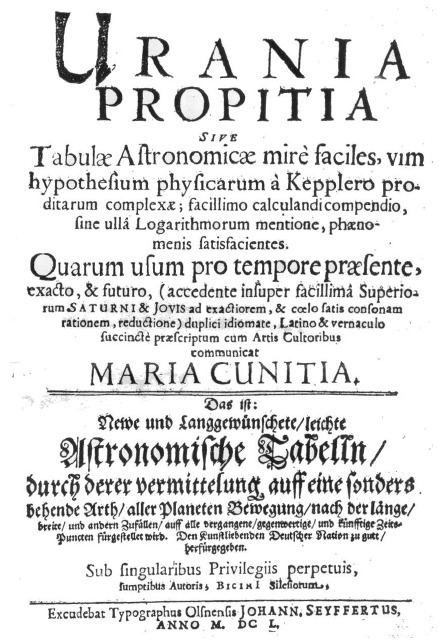 | ||
Urania Propitia is a book of astronomical tables written by Maria Cunitz and published in 1650. As Maria Cunitz was the daughter of both a physician and mathematician, it was her ability to grasp complex mathematics quickly and transcribe her findings as a polyglot that allowed her to do what not many women had done before her.
Contents
Introduction
Urania Propitia was a simplification of the Rudolphine Tables written by Johannes Kepler in 1627. Kepler's dedication to Emperor Ferdinand II which was originally dedicated to Rudolf II was filled with complex and tedious logarithms. It was because of Kepler's ingenious yet tiresome use of logarithms that led Cunitz to simplify the Rudolphine Tables and make Kepler's work more accessible to the public. The tables are mostly astrological, but the instructions are completely astronomical. Written in both German for "the fatherland" and Latin to make it more accessible, the instructions are more practical in German and technical in Latin. Beyond the instructions, Maria Cunitz's book is split into three parts.
Part 1: Tables for spherical astronomy
The first part is the mathematical starting point. These include "sexagesimal sines, solutions of small right triangles in minutes and seconds, and tables for spherical astronomy for degrees of the ecliptic of: declination, right ascension, oblique ascension for latitudes 0 degrees to 72 degrees at 2 degree intervals..."
Part 2: Tables of average motions
It is the second part that the heart of Maria Cunitz's simplification is brought forward. Using the geometry and spherical astronomy from part one, Cunitz brings the rotational motions of the planets and moons into light using various mathematical formulas. One of the formulas from the Rudolphine Tables,
where e, M and E denote the orbital eccentricity, the mean anomaly and the eccentric anomaly. This equation is known as "Kepler's equation" which normally has no "geometrical or algebraic solution for E." However, when M is given it becomes more possible to but find "E from M to any degree of precision by iteration or interpolation." The major accomplishment Cunitz brought was the ability to compute
Part 3: Tables for computation of eclipses
These tables were used for both the location of eclipses and the time of eclipses. This includes the use of the "golden astronomical number", the parallax of the moon and sun in a variety in longitude, latitude, altitude, etc..., and a catalog of other fixed stars in the universe.
Cosmology
Cunitz's cosmology has variations of both Tycho Brahe and Johannes Kepler. While the basic structure of her cosmology is like Tycho's with the sun and moon orbiting around the Earth while the rest of the planets orbit around the sun, the physics within the cosmos involves ellipticals and "aphelions."
Historical significance
Beyond the rewards that came from a simplification of the Rudolphine Tables, a scientific advance written by a woman in the seventeenth century was an accomplishment in itself. It was described by Noel Swerdlow as "the earliest surviving scientific work by a woman on the highest technical level of its age." It was common for male scientists before Maria Cunitz to attribute their discoveries to muses. For Urania Propitia, Urania in Greek mythology was the muse of Astronomy and "Propitia" translates to favoring in Latin. This suggests that Maria Cunitz both saw Urania as her muse while also making strides for women as scientists because she could be so easily compared to the ancient Greek astronomer.
